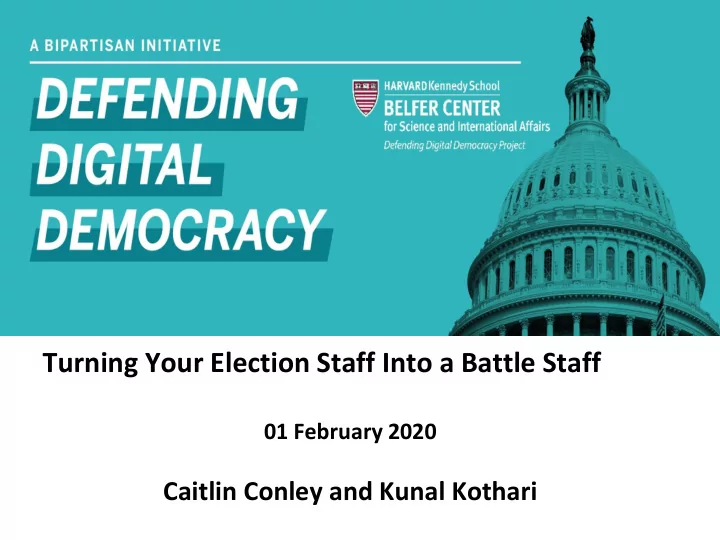

Turning Your Election Staff Into a Battle Staff 01 February 2020 Caitlin Conley and Kunal Kothari
Where we teach you to build this
AGENDA INTRODUCTION PEOPLE AND PURPOSE SHARED SITUATIONAL AWARENESS THRU COMMUNICATION TAKING ACTION: INCIDENT TRACKING, ANALYSIS AND RESPONSE OPERATIONS CENTER
What is a Battle Staff? Battle Staff A Battle Staff is a military headquarters element activated to support ongoing operations across multiple echelons (levels of organization). A Battle Staff optimizes decision-making by improving cross-functional collaboration and increased understanding of the operating environment in order to ensure mission critical processes are reliable, repeatable, and efficient.
People and Purpose
Map Out Your Election Ecosystem Coordinating Relationship Federal Battle Operational Control Staff/Cyber Situational Awareness Room Other State Battle Governor Staffs State Battle Staff All County Battle State Agencies Staffs EOC/Law Media Enforcement Political Orgs County Battle Staff Vendors NGOs County IT Warehouse County Election Staff Field Support (Rovers) Voting Locations Call Center Equipment Center
Sharing the Load: Distributing Lines of Effort Across the Team Incidents encountered during election operations generally can be divided into one of three categories, which in turn drives who is responsible for the resolution . Problem Responsible Type Simple Firstline Staff An expected problem with a known Call Center Employees, Poll Workers solution that does not require Can solve the overwhelming majority of simple expertise to resolve. issues by following SOPs. Complicated Technically Trained Staff/Skilled Experts A problem (expected or unexpected) IT, Election Coordinators, Rovers that requires expertise to resolve. Can address complicated issues. Complex Battle Staff A problem that involves too many Subject Matter Experts unknowns for standard procedures Core of coordinating and managing election to resolve and requires both operations at all levels. expertise and critical thinking.
Increasing Efficiency and Reliability Standard Operating Procedures (SOPs) ● S tep-by-step instructions to perform routine operations for common or anticipated events. ● SOPs help teams perform efficiently and effectively A good SOP is concise, easily repeatable, unambiguous, and clearly defines what is flexible or inflexible.
Election Operations Center Incident Tracker Dashboard
Shared Situational Awareness through Communication
Step 1: Identify Communication Paths (Who) Rover Team 1 Polling Polling Site 1 Site 5 Communication Paths Based on your elections ecosystem, Voting Location identify your communication paths: Support Chat Identify who needs to communicate Group with whom. Polling Polling Site 2 Site 4 Polling Site 3 While we are focused on the who here, think through why these specific teams need to be connected.
Step 2: How to Communicate (What) Your primary method of communication should always be the most time efficient and reliable . The best way to achieve this will depend on the type and purpose of the information being conveyed.
Step 3: PACE Plan (What) P rimary Determine Backup Communications Plans • Identify available communication methods, including web-, phone-, radio-based and in-person (the Battle Staff in the operations center should have a list of all available A methods of communication) lternate • Decide which are most effective and reliable based on the path’s purpose. • Choose the four best methods • Create a PACE Plan for each Critical Communication Path C ontingency Here’s an Example… E mergency P rimary : Text via Chat Group A lternate (Secondary) : Phone call point-to-point (use call roster list) C ontingency : Email notification E mergency: Tactical/Emergency Radio (if available) or in person
Step 4: When to Communicate (When) Scheduled Information • Initial Guidance Brief • Periodic Update Briefs • External Stakeholder Updates Unscheduled Information 1. Who was affected by the event? Precinct 4 2. What happened? Poll worker told about tweet accusing County X of voter discrimination 3. When did it happen? Tweet posted at 9:00 am; reported at 9:20 am 4. Where did it happen? Online: Twitter 5. Why is it important: Does it answer a Critical Information Requirement (CIR) or require additional action from someone? CIR #7
Taking Action: Election Incident Tracking, Analysis, and Response
Why is an Incident Management Process Needed? ● Connecting people, resources, and information ● Streamline responses and operations ● Keep stakeholders informed at the right level with the right information
Information to Capture 1. What information do I need in order to make decisions? 2. How will information be input, collected, and analyzed? 3. How will the system enable and empower everyone involved to have the most accurate information at a given point in time? PRACTICE: Your team tells you about an incident impacting voting operations. Voters are unable to cast ballots. Discuss with your neighbor how you would use the questions above to prepare your team to adequately respond to this type of incident.
Identifying Critical Information Requirements (CIRs)
Incident Handling Examples
Analysis and Resolution
Bringing it all Together: The Operations Center
Purpose of an Operations Center A centralized location where a leader and key What an Ops staff come together to command, control, and Center IS coordinate all operational activities. What an Ops A ‘team room’ or a place to hang out; a place Center ISN’T for ‘peripheral’ actors (e.g., media)
What an Operations Center Can Do For You CENTRALIZES Provides a central place to manage ongoing operations. STRUCTURES Provides structure and predictability to operations through established ‘battle rhythms’ and standard operating procedures (SOPs). MITIGATES RISK Layout and structure mitigates preventable issues/risk through effective dissemination of key communications and information FACILITATES UNDERSTANDING Facilitates each individual member’s holistic understanding of the operation (making the whole greater than the sum of its parts).
Election Operations Center Incident Tracker Dashboard
https://www.belfercenter.org/publication/elections-battle-staff- playbook
Recommend
More recommend